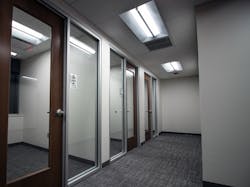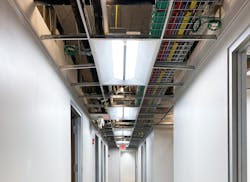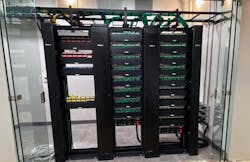By Andrew Clark, RCDD, Continuity Consulting, LLC
Organized in 1923, United Way of Central Alabama (UWCA) has a rich history in helping neighborhoods and communities in the region. As one of the few United Way chapters in the nation that provides direct services to its community, UWCA raises over $97 million in contributions and federal grants and contracts annually to support more than 200 programs and initiatives focused on ensuring quality education, financial stability, health and access to vital emergency services.
View this article in Cabling Installation & Maintenance's March 2021 Responsive Digital Edition, along with these other stories:
While the United Way may not typically be associated with technology, UWCA was one of the first non-profit organizations to deploy an advanced Cisco Unity phone system nearly 20 years ago to support 2-1-1 call distribution of the entire state of Alabama. This free and confidential phone service serves as the initial contact point for Alabamans to locate a multitude of available community services. As one of the largest United Way chapters in the country, UWCA continually leverages technology to improve its overall operational efficiency. It doesn’t hurt that Doug Goodwin, UWCA’s vice president of information systems of more than 20 years, is an early adopter when it comes to technology.
With the combination of Doug’s electrical and IT experience and a local up-and-coming solution provider with a forward-thinking approach to providing high-quality technology implementations, UWCA decided to implement an advanced Power over Ethernet (PoE) lighting system for its new 40,000 square-foot expansion project.
A smart, cost-effective decision
The decision to go with an all PoE lighting system for UWCA’s new facility was not made lightly, especially since few architects have completely embraced the technology over traditional LED lighting systems powered via line voltage. While the UWCA’s building has a modern feel to it, and PoE lighting certainly adds to that, the decision primarily came down to cost and operational efficiency.
“I’ve had an eye on PoE lighting for quite some time. While a line voltage LED lighting system would have given us control features, it would not give us the capabilities we could leverage by having the lights connected to the switched Ethernet network,” says Doug. “It wasn’t just about having more granular control and built-in features like occupancy sensing, daylight harvesting and color tuning. I knew that PoE lighting would give us the potential to integrate with other building systems like HVAC to ultimately lower our operational costs. We pride ourselves on being good stewards of our funding and having the lowest possible administrative overhead.”
Another key consideration from an operational standpoint included the potential for reduced maintenance costs since lighting fixtures could be easily replaced and reconfigured by IT staff. The PoE lighting system also provided greater flexibility in that the network cabling infrastructure used to connect and power the fixtures could easily be leveraged for other network devices or to support future technologies. For example, connected sensors integrated into PoE lighting fixtures can be used to collect and share a variety of data like usage patterns, temperature, and humidity to achieve even greater operational efficiencies. Being connected to the network also provides the opportunity for the PoE lighting system to integrate with security systems, and many of these systems might someday be outfitted with capabilities like gunshot detection or automatically changing light color or implementing on/off patterns during a crisis.
While the integration capabilities and potential operational efficiencies were appealing, as a non-profit organization funded via grants and donor funds, UWCA also needed to pay close attention to initial costs.
“We have a long-standing relationship with the United Way here in Birmingham and wanted to ensure that PoE lighting was the most strategic and cost-effective decision for them,” says Carl Sosnin of Continuity Consulting, the full-service technology solutions provider responsible for the design and implementation of the low-voltage systems for the new facility. “We worked closely with UWCA to conduct a thorough budget comparison between a line voltage and PoE lighting system, and given the labor savings, the PoE system ended up being a less expensive option. This also helped us obtain buy-in from the building design team who originally put forth a line-voltage lighting system as part of the specification.”
The decision to go with PoE lighting was also due to experience on the part of Continuity, who had previously deployed the technology in their own office space. “The fact that our low-voltage contractor had experience with PoE lighting also put us at ease,” says Doug. “This technology is still new to most electrical contractors, especially the integration of the lighting system with the network systems. Data switches and routing are simply not in their repertoire, which would have put the onus on UWCA to handle the integration. Continuity is run by some smart people with whom I share a similar work and craftmanship mentality, so I knew they could handle the job and handle it well.”
A strategic, futureproof solution
Once the decision was made to implement PoE lighting, Continuity and UWCA needed to ensure a flexible, quality implementation for the fixtures, as well as for all other low-voltage applications. They also needed to ensure that the lighting system would accommodate immediate needs such as color tuning and motion sensing, while ensuring support for future capabilities.
“In selecting a lighting system, we found that Cree Lighting was one of the few manufacturers who had product ready to ship. Most other options had lead times that varied from 10 to 50 weeks,” explains Carl. “We also preferred Cree Lighting’s one-to-one fixture-centric topology versus a node-centric topology that limited flexibility and added a potential point of failure. The system also had all of the capabilities we were looking for, and Cree Lighting provided design support, including an on-site programmer to help us commission the system.”
While Cree Lighting was ready to provide on-site support as needed, the system is considered extremely easy to use and comes with a 10-year warranty. “We were happy to be onsite to commission the system, but it is extremely easy to use. Once the fixtures have power, the lights are on. And once ‘go’ is initiated in the SmartCast platform, all the fixtures become smart, controllable devices. Most tweak the lights after a couple of weeks to suit their personal preference, but then it’s designed to completely function on its own,” explains Drew Kolb, director of strategic business development, IoT, for Cree Lighting. “With this system’s API, the potential for the amount of data is impressive—especially with both UWCA’s and Continuity’s know-how in using open protocols to enable devices to talk to each other. It will be exciting to witness the system as it matures and how they will ultimately use the data to lower their operating expense.”
The fixtures and controls for the system require a range of 22 to 50W, which can be supported via IEEE 802.3bt Type 3 PoE. Due to the potential heat rise that can occur within cabling bundles carrying this level of current and its impact on transmission performance (e.g., insertion loss), Continuity connected fixtures throughout the building using the Panduit and General Cable PanGen® structured cabling solution with General Cable’s GenSPEED® 6 Category 6, 22-AWG limited power (LP)-rated cable and Panduit Category 6 connectivity. With a temperature rating of 90 degrees C and large gauge construction, the LP-rated cables reduce heat generation and associated insertion loss, allowing for more reliable data transmission, efficient power delivery and larger cable bundles.
“We chose the LP cable to support higher 120-watt PoE should we ever need it,” says Carl. “Ten years from now, we may see PoE lighting fixtures with an even broader range of integrated technologies—all in one device.”As a strong supporter of PoE lighting, Panduit has significant experience working with contractors and customers to deploy the technology. In fact, the Panduit Experience Center features a PoE lighting installation that enables their customers and partners to experience firsthand the benefits of the technology and how it works. Panduit has also enhanced their products to work effectively with PoE.
"LP-rated cable is a great choice for PoE lighting. It removes much of the uncertainty from the equation, and customers and contractors can feel comfortable knowing that the cable will reliably deliver power,” says Frank Straka, Panduit’s product line manager for copper systems. "What a lot of people don't realize is that the connector is also an important part of that PoE channel. Heat rise can also impact connectors, along with arcing at the engagement point. Panduit jacks are designed to manage both of these factors, so PoE delivery won't impact the performance of the channel."
To connect the PoE lighting fixtures, Continuity used Panduit Mini-Com® 2-port surface mount boxes with Mini-Com Category 6 modules mounted in the plenum space. Each fixture connects to a port in the surface mount box with a patch cord.
“We deployed surface mount boxes for connecting lighting fixtures primarily for administration, flexibility and futureproofing. It is always our preference to terminate horizontal cables to an outlet and connect devices using shorter patch cables,” says Carl. “This enables proper labeling of the structured cabling for easier moves, adds and changes, while also providing a more secure, stable connection. The outlets in the surface mount boxes can be leveraged for any IP-based technology, and future handling and reconfigurations of lighting fixtures can be accommodated using patch cords without impacting the fixed location and reliability of outlets.”
A challenging, coordinated endeavor
The 40,000 square-foot, three-story building purchased by UWCA for the expansion sits next door to their current facility, which houses the main computer room and connects to the new building via 24 strands of singlemode optical fiber. The new building has been completely renovated down to the concrete and includes a new call center for the 2-1-1 service, offices and even a full kitchen to support the UWCA-administered local Meals on Wheels program that delivers daily hot meals to homebound seniors. While the new building will accommodate UWCA’s growth and enable enhanced services to the region, the overall project was not without challenge.
In addition to the PoE lighting system, Continuity provided the design and installation for all other low-voltage systems, including network-based video surveillance, access control and Aruba WiFi—all connected and powered over a Cisco switched network supported by a PanGen structured cabling system. For audiovisual systems, Continuity deployed an AtlasIED multi-zone audio system for background music and sound masking in the call center and an advanced ClearOne conferencing platform with 2X2 ceiling tile beamforming mic arrays with built-in acoustic echo cancellation, noise cancellation and beam selection. While ceiling space was a challenge, the overall decision to deploy a PoE lighting system also required significant coordination with lessons learned along the way.
“When working on a construction project, the various trades responsible for the finishing touches are used to having line-voltage lights up and running. But with PoE lighting, you’ve got to reverse your thinking and get the telecom rooms done in record time,” says Doug. “Fortunately, the Continuity team did a great job managing the chaos. I definitely learned a lot—if I was going to do it again, I would make sure to coordinate earlier with the general contractor to explain the key differences between traditional lighting and PoE lighting so they would understand well in advance what they would be dealing with.”
A feel-good, cutting-edge outcome
In a project completed in less than year, everyone involved is extremely pleased with the outcome and the future potential of PoE lighting.
“Building technology seems to be where telephones were 20 years ago. It’s rapidly evolving, and we believe PoE lighting will really take off over the next few years,” says Carl. “The United Way of Central Alabama project will allow us to demonstrate our quality of work and the range of technologies we can install. We are very proud to be a part of it.”
Drew Kolb from Cree Lighting wholeheartedly agrees and also sees endless possibilities for PoE lighting. “We’re already seeing intelligent lighting sensors used to analyze the environment, temperature, pressure, VOC gas and humidity. We are very excited for the United Way to have access to all the opportunities that come with this technology,” he says. “Honestly, I’ve also appreciated the personal experience. We’ve all had some interaction with the United Way, and I’ve donated and volunteered my own time over the years. And that makes this project more special than the average commercial enterprise.”
Looking back over the past year, Doug is certain they made the right decision by choosing PoE lighting for the expansion project and is excited for the future. “United Way of Central Alabama has had 17 consecutive four-star ratings from Charity Navigator, and we pride ourselves on always doing what we say we’re going to do and staying below our administrative overhead,” he says. “The PoE lighting system at our new facility is no exception. It wasn’t a guessing game and we didn’t take any risk. It was the right time for us to choose this approach, and we’re confident that we will end up with operational savings and improved functionality.”
Andrew Clark, RCDD, is owner of Continuity Consulting, LLC (www.continuity8.com). He founded the company in 2014 to provide design and technology implementation for a variety of businesses using a forward-thinking, customer-focused approach and a belief that the work should be done correctly the first time.





